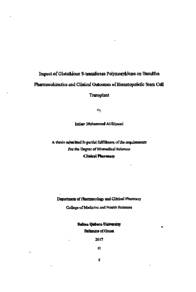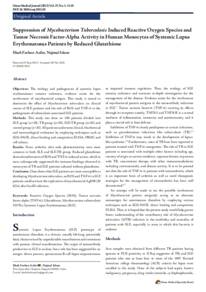Document
Impact of glutathione S-transferase polymorphisms on busulfan pharmacokinetics and clinical outcomes of hematopoietic stem cell transplant
Publisher
Sultan Qaboos University
Gregorian
2017
Language
English
Subject
English abstract
Background
Busulfan (Bu) an alkylating drug, belongs to the Alkyl methanesulfonates group, works directly by alkylating DNA, and results in cross-linking of DNA strands leading to apoptosis. Bu is a vital drug in most of the conditioning regimens prior to Hematopoietic Stem Cell Transplant (HSCT). Bu metabolism occurs in the liver, where it initially gets conjugated to glutathione catalyzed by mainly Glutathione S-transferase isoenzyme Al-1 (GSTAI). There are other isoenzymes (GSTM1, GȘTT1 and GSTP1) involved but in a lower extent. As soon as Busulfan is conjugated, it loses its alkylating property. The hematopoietic stem cells have very minimal to none isoenzymes in the cell leading to an increased Bu effect in them. The Glutathione family has a high chance of polymorphism, hence affecting some pharmacokinetic profiles of Bu, and clinical outcomes of the HSCT.
The study aim is to assess the role of GST genetic variants in affecting the clearance of Bu and clinical outcomes of patients undergoing HSCT. This will allow us to observe the frequency of GST polymorphism and would better explain the busulfan clearance and hematopoietic stem cell transplant outcomes.
Methods
A single center retrospective cohort study with genotyping of previously collected samples (as standard of care) for the known polymorphism of GST related to Bu metabolism. Inclusion criteria were 135 adult and pediatric patients who received IV Bu prior to HSCT at SQUH from January 2003 - October 2016. Patient's Bu clearance was calculated using Kinetica software. Genotyping for polymorphism was done using Capillary Electrophoresis for GSTM1 and GSTT1 (insertion or deletion), and DNA sequencing for GSTA1 (G-52A, C-69G, A-513G, T-567G, G -631T and G-1142C) and GSTP1 (A313G and C341T). Each GST polymorphism was analyzed and checked if it was a factor causing a difference in busulfan clearance and HSCT outcomes such as aGvHD, VOD, graft loss, relapse, and mortality. Standard descriptive and analytical statistics and graphs were created using STATA.
Results
The total number of patients that were included is 135, of which 63 males and 72 females. The mean Bu clearance in our population was found to be 3.7 +0.98 ml/min/kg. Thirty patients developed a GvHD, 9 developed hepatic VOD, 4 developed
graft loss, and 5 died. While from the acute leukemia and MDS patients, 5 relapsed. The
frequency of GSTMI deletion in our population is 41%, GSTTI deletion is.16% and double insertion of GSTMI and GSTT) combined is 50%. The wild type, heterozygous and homozygous genotypes of each location of GSTAI are as following, G-52A, 35%, 48% and 17%, C-69G; 38%, 48% and 14%, A-513G; 0%, 4% and 96%, T-567G; 18%, 44% and 38%, G -631T;60%, 33%, and 7% and G-11420, 42%, 41% and 17%. The wild type, heterozygous and homozygous genotype of each location of GSTPI is as follows, A313G; 47%, 40% and 13%, and C341T; 84%, 16% and 0%. Patients with GSTAI A-513G heterozygous (AG) were found to have higher incidence of graft loss (p= 0.006), and with double GSTMI and GSTT1 double deletion, there was a higher incidence of aGvHD (p=0.04). Double insertion of GSTMI and GSTTI significantly increased the risk of mortality p=0.034, and GSTM1 insertion is also associated with increased mortality p=0.021.
Conclusions From these results we propose that GST genotyping prior to HSCT influences clinical outcomes, and might improve clinical outcomes for known genetic background.
Description
Thesis
Member of
Resource URL
Arabic abstract
الخلفية العلمية
يعمل دواء البيولفان المصنف من ضمن مجموعة الmethanesulfonates بشكل مباشر بعملية أكلنت الحمض الجيني النووي ومع الناتجة عن الترابط المتبادل لشرائط الأحماض الجينية ليؤدي إلى عملية الapoptosis (موت الخلايا تحت الظروفه المتحكمة). ويعتبر مادة البيولفان هو دواء هام في معظم المراحل التحضيرية لعملية زراعة خلايا الدم الجذعية ويحدث العملية الأيضيية لمادة البوسلفان في الكبد، حيث يتم مبدأيا رفقه مع Glutathione المحفزبواسطة (Glutathione S - transferase isoenzyme A1 - 1 ( GSTA1 و بشكل عام، هنالك أنزيمات أيزو أخرى مثل ( GSTM , GSTTI , GSTP1 مشتركة في هذه العملية ولكن بفاعلية أقل. وفورا، يفقد دواء البيوسلفان خاصته المؤلكلة ,وعلى كل حال، إن مكونات الدم الخلايا الجذعية لها أنزيمات قليلة أو تكاد تكون معدومة في تركيبة خلاياها مما يترتب إلى زيادة فاعليتها. إن عائلة ال Glutathione لديها الفرصة الكبيرة في تعدد الأشكال مما يؤدي إلى التأثير على بعض الميزات الهوائية، والنتائج السريرية من عملية زراعة النخاع.
إن الهدف من هذا البحث هو تقيم دور GST الجينات المتعددة في النواتج السريري و الخالصة لدى المرضى الذين أعطوا دواء البوسلفان في المرحلة التحضيرية قبل زراعة النخاع. ستسمح لنا هذه الدراسة بمراقبة مني تكررتعدد أشكال ال GST حيث أنه لم يتم التعرف إلى الآن على إحصائية دقيقة في السلطنة لهذه الحالات، فسلقكننا هذه المراقبة بشرح أفضل النتائج معدلات تصفية البيوسلفان من الجسم و أثرها على نتيجة عملية زراعة النخاع الطرق: طبيعة الدراسة إتبعت طريقة واحدة مركزية في التنميط الجيني للعينات المجمعة مسبقار والمأخوذة بعناية من GST. أما بالنسبة للفئة المختبرة، فقد تم حصرها في 135 مريض من البالغين والأطفال الذين تلقوا الدواء من خلال الIV التطعيم الوريدي المباشر) كجزء من تحضيرهم من قبل زراعة النخاع بمستشفى جامعة السلطان قابوس من يناير 2003 إلى أكتوبر 2016. وتم حساب كمية الدواء بواسطة برنامج اليKinetica .أما التنميط الجيني لتعدد الأشكال فقد تم من خلال حساب الشعرية الكهربائية ل GSTM1 و GSTTI إدخالأوإلغاء DNA ,وعملية حساب التسلسل للحمض الجيني كالتالي GSTA1 ( G - 52A , C - 69G , A - 513G , T - 567G , G - 631T : G - 1142C ) and GSTP1 A313G و .(C341T ولكل تحور GST تم تحليل والكشف عنه لمعرفة ما إن كان عاملا مسببا في إختلاف نتائج دواء البيوسلفان و زراعة النخاع من أمثال aGvHD (داء مهاجمة خلايا المتبرع لجسم المريض المتلقي)، مرض انسداد الوريد الكبدي، و معاودة المرض، أو حتى الموت وأما ما له علاقة بالوصف وتصاميم الإحصاءات التحليلية والرسومات الجرافية فتم الإعداد له بواسطة برنامج .STATA
النتائج
بلغ عدد المرضى المحتوين في الدراسة إلى 135 (63 نور و 72 إناثا). أما متوسط كمية معدلات تصفية البيوسلفان من الجسم فكان بكمية 3 . 7 + 0 . 98 مل/د/کج وتوصلت الدراسة إلى أن 30 من المرضى تطورت لديهم حالةaGvHD (خسارة حادة للتطعيم مقابل المضيف المريض) و و أخرون أصيبوا بمرض انسداد الوريد الكبدي بينما 4 رصدت لهم حالة فقدان التطعيم ، و 5 توفوا. وأيضا يتوجب الإشارة إلى أن المرضى المصابين بلوكيميا حادة و MDS (متلازمة خلل التنسج النقوي) عاودت عوارض المرض لدي 5 منهم. وأما بما يخص معدل تكرر GSTM1إلغاء فكانت نسيته41% و الغاء GSTT1 % 16، و وجود للكل من GSTM1و GSTT1معا هو % 50. أما النسب للأنواع من التنميط الجيني مثل heterozygous ,wild type و homozygous في موقع GSTA1كان كالتالي: G-52A; 35%, 48% and 17%, C-69G; 38%, 48% and 14%, A-513G; 0%, 4% and 96%, T-567G; 18%, 44% and 38%, G-631T;60%, 33%, and 7% and G-1142C; 42%, 41% and 17%. و أما نسب التنميط الجيني لذات الأنماط المذكورة أعلاه، في موقع GSTP1 كان كالتالي: A313G; 47%, 40% and 13%, and C341T;84%, 16% and 0%. وتوصل البحث أن المرضي ذا ترکيبة وصفية (GSTA1 A -
513G heterozygous ( AG قد وجدوا أنه يحدث لديهم نسبة عالية من خسارة الفقدان التطعيم0 . 006 =p ، و أما الغاء مضاعف ل GSTM1 و GSTT1 فتزداد نسبة حدوث إرتفاع فيaGyHD (خسارة حادة للتطعيم مقابل المضيف المريض) ( 0 . 04=p) و يلاحظ أن نسبة الإدخال المضاعف ل GSTM1 و GSTT1 يرفع نسبة الوفاة بشكل خطير 0 . 034=p، ويرتبط تواجد ال GSTM1 مع زيادة نسبة الوفيات 0 . 02=p .
الخلاصة
تقترح النتائج المستخلصة إلى أن ال GST قبيل عملية الزراعة تؤثر على نتيجة زراعة النخاع بإمكاننا تحسین نتائج الزراعة الأنواع الجينات المعروفة
يعمل دواء البيولفان المصنف من ضمن مجموعة الmethanesulfonates بشكل مباشر بعملية أكلنت الحمض الجيني النووي ومع الناتجة عن الترابط المتبادل لشرائط الأحماض الجينية ليؤدي إلى عملية الapoptosis (موت الخلايا تحت الظروفه المتحكمة). ويعتبر مادة البيولفان هو دواء هام في معظم المراحل التحضيرية لعملية زراعة خلايا الدم الجذعية ويحدث العملية الأيضيية لمادة البوسلفان في الكبد، حيث يتم مبدأيا رفقه مع Glutathione المحفزبواسطة (Glutathione S - transferase isoenzyme A1 - 1 ( GSTA1 و بشكل عام، هنالك أنزيمات أيزو أخرى مثل ( GSTM , GSTTI , GSTP1 مشتركة في هذه العملية ولكن بفاعلية أقل. وفورا، يفقد دواء البيوسلفان خاصته المؤلكلة ,وعلى كل حال، إن مكونات الدم الخلايا الجذعية لها أنزيمات قليلة أو تكاد تكون معدومة في تركيبة خلاياها مما يترتب إلى زيادة فاعليتها. إن عائلة ال Glutathione لديها الفرصة الكبيرة في تعدد الأشكال مما يؤدي إلى التأثير على بعض الميزات الهوائية، والنتائج السريرية من عملية زراعة النخاع.
إن الهدف من هذا البحث هو تقيم دور GST الجينات المتعددة في النواتج السريري و الخالصة لدى المرضى الذين أعطوا دواء البوسلفان في المرحلة التحضيرية قبل زراعة النخاع. ستسمح لنا هذه الدراسة بمراقبة مني تكررتعدد أشكال ال GST حيث أنه لم يتم التعرف إلى الآن على إحصائية دقيقة في السلطنة لهذه الحالات، فسلقكننا هذه المراقبة بشرح أفضل النتائج معدلات تصفية البيوسلفان من الجسم و أثرها على نتيجة عملية زراعة النخاع الطرق: طبيعة الدراسة إتبعت طريقة واحدة مركزية في التنميط الجيني للعينات المجمعة مسبقار والمأخوذة بعناية من GST. أما بالنسبة للفئة المختبرة، فقد تم حصرها في 135 مريض من البالغين والأطفال الذين تلقوا الدواء من خلال الIV التطعيم الوريدي المباشر) كجزء من تحضيرهم من قبل زراعة النخاع بمستشفى جامعة السلطان قابوس من يناير 2003 إلى أكتوبر 2016. وتم حساب كمية الدواء بواسطة برنامج اليKinetica .أما التنميط الجيني لتعدد الأشكال فقد تم من خلال حساب الشعرية الكهربائية ل GSTM1 و GSTTI إدخالأوإلغاء DNA ,وعملية حساب التسلسل للحمض الجيني كالتالي GSTA1 ( G - 52A , C - 69G , A - 513G , T - 567G , G - 631T : G - 1142C ) and GSTP1 A313G و .(C341T ولكل تحور GST تم تحليل والكشف عنه لمعرفة ما إن كان عاملا مسببا في إختلاف نتائج دواء البيوسلفان و زراعة النخاع من أمثال aGvHD (داء مهاجمة خلايا المتبرع لجسم المريض المتلقي)، مرض انسداد الوريد الكبدي، و معاودة المرض، أو حتى الموت وأما ما له علاقة بالوصف وتصاميم الإحصاءات التحليلية والرسومات الجرافية فتم الإعداد له بواسطة برنامج .STATA
النتائج
بلغ عدد المرضى المحتوين في الدراسة إلى 135 (63 نور و 72 إناثا). أما متوسط كمية معدلات تصفية البيوسلفان من الجسم فكان بكمية 3 . 7 + 0 . 98 مل/د/کج وتوصلت الدراسة إلى أن 30 من المرضى تطورت لديهم حالةaGvHD (خسارة حادة للتطعيم مقابل المضيف المريض) و و أخرون أصيبوا بمرض انسداد الوريد الكبدي بينما 4 رصدت لهم حالة فقدان التطعيم ، و 5 توفوا. وأيضا يتوجب الإشارة إلى أن المرضى المصابين بلوكيميا حادة و MDS (متلازمة خلل التنسج النقوي) عاودت عوارض المرض لدي 5 منهم. وأما بما يخص معدل تكرر GSTM1إلغاء فكانت نسيته41% و الغاء GSTT1 % 16، و وجود للكل من GSTM1و GSTT1معا هو % 50. أما النسب للأنواع من التنميط الجيني مثل heterozygous ,wild type و homozygous في موقع GSTA1كان كالتالي: G-52A; 35%, 48% and 17%, C-69G; 38%, 48% and 14%, A-513G; 0%, 4% and 96%, T-567G; 18%, 44% and 38%, G-631T;60%, 33%, and 7% and G-1142C; 42%, 41% and 17%. و أما نسب التنميط الجيني لذات الأنماط المذكورة أعلاه، في موقع GSTP1 كان كالتالي: A313G; 47%, 40% and 13%, and C341T;84%, 16% and 0%. وتوصل البحث أن المرضي ذا ترکيبة وصفية (GSTA1 A -
513G heterozygous ( AG قد وجدوا أنه يحدث لديهم نسبة عالية من خسارة الفقدان التطعيم0 . 006 =p ، و أما الغاء مضاعف ل GSTM1 و GSTT1 فتزداد نسبة حدوث إرتفاع فيaGyHD (خسارة حادة للتطعيم مقابل المضيف المريض) ( 0 . 04=p) و يلاحظ أن نسبة الإدخال المضاعف ل GSTM1 و GSTT1 يرفع نسبة الوفاة بشكل خطير 0 . 034=p، ويرتبط تواجد ال GSTM1 مع زيادة نسبة الوفيات 0 . 02=p .
الخلاصة
تقترح النتائج المستخلصة إلى أن ال GST قبيل عملية الزراعة تؤثر على نتيجة زراعة النخاع بإمكاننا تحسین نتائج الزراعة الأنواع الجينات المعروفة
Category
Theses and Dissertations


